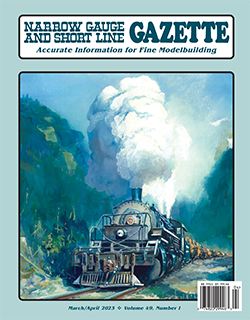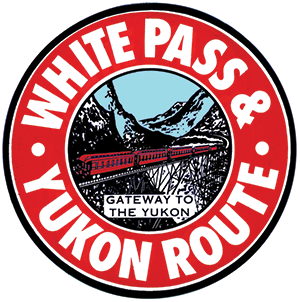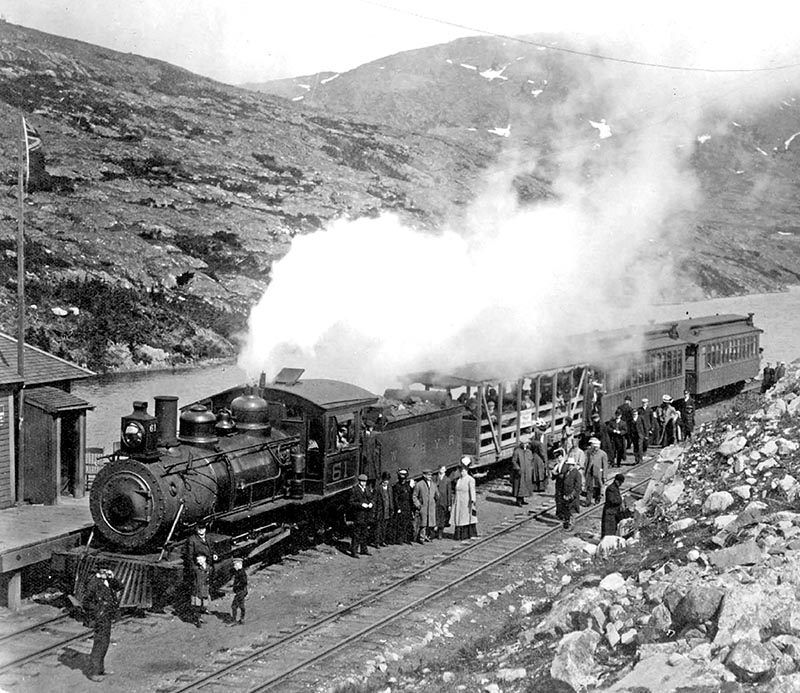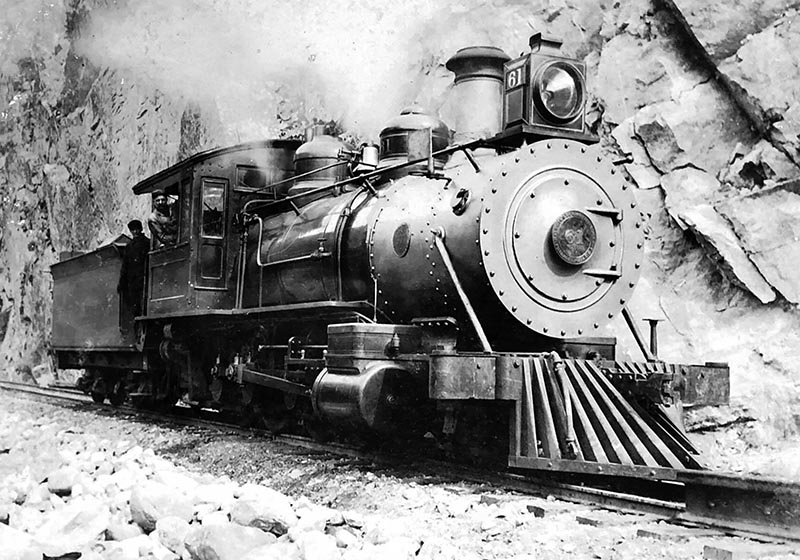
By Rob Bell/photos as noted
The steep grade from Skagway, Alaska, snakes its way up the Coast Range Mountains north of the town. The grade pushes four percent on the way to the summit some twenty miles away. Those twenty miles push a locomotive to its limits. In Part 6, I covered the four locomotives that were the White Pass & Yukon Route’s main motive power for nearly forty years. At the same time the first two of those were ordered from Baldwin Locomotive Works, the WP&YR ordered two other unique locomotives on December 8, 1899.
The third locomotive was an outside-framed 2-8-0, Consolidation type engine, Baldwin class 10-28E. Built in May of 1900 as Baldwin construction number 17814, she was numbered 61, had a 60-inch diameter boiler, 17- x 20-inch cylinders, 38-inch diameter drivers, and carried about 90,000 lbs. on her drivers when in working order. Number 61 used a deep-square (DS) firebox style set be-hind the driving axles like the fireboxes of the 59-class discussed in Part 6. The design generated a tractive effort of 23,300 lbs. Unlike the rest of the White Pass locomotives of the time, No. 61’s boiler backhead stuck out the rear of the cab. If the WP&YR had used D&RG terminology, it would have been classed a C-23, (“C” for Consolidation and “23” for 23,000 lbs. tractive effort). According to long time White Pass engineer, the late J.D. True, No. 61 could handle 140 tons up the grade out of Skagway.
 For the first seven years or so, No. 61 was the strongest locomotive on the WP&YR roster. During the warmer months, No. 61 was most likely used either by herself at the head of a train or as a helper on “the hill” out of Skagway. While No. 61 could easily slug it out on the steep grades between Skagway and Bennett, her 38-inch diameter drivers meant she could not keep up with the 59-class and their 42-inch drivers north of the White Pass summit. She was normally assigned as the second pusher on the rotary fleet during the winters. There is no evidence that No. 61 ever sported a snow plow like the 59-class did.
For the first seven years or so, No. 61 was the strongest locomotive on the WP&YR roster. During the warmer months, No. 61 was most likely used either by herself at the head of a train or as a helper on “the hill” out of Skagway. While No. 61 could easily slug it out on the steep grades between Skagway and Bennett, her 38-inch diameter drivers meant she could not keep up with the 59-class and their 42-inch drivers north of the White Pass summit. She was normally assigned as the second pusher on the rotary fleet during the winters. There is no evidence that No. 61 ever sported a snow plow like the 59-class did.
The late Eric L. Johnson related the following story in his book The Copper Mines Branch (2017). On March 18, 1918, rotary No. 2 turned over on the Copper Mines Branch, killing two men. Also called the Pueblo Spur, this branch left the WP&YR main line about six miles south of Whitehorse, Yukon Territory. The Branch was built to access copper ore from several mines in the area known as the Whitehorse Copper Belt. Construction of the Pueblo Spur started in October 1907 and the first seven miles were completed in 1908. An additional four miles were completed in 1910, giving a total length of just over eleven miles.

ABOVE: A southbound excursion “extra” pulled by WP&YR 61 has stopped at the summit where the Canadian border is. The photo dates to 1906 and 61 no longer has the fancy capped stack. The train consists of an open-air excursion car and two passenger cars of different styles, giving insight to the varied rolling stock owned by the line in the early days. —Photo by Case & Draper, courtesy National Park Service, Klondike Gold Rush National Historical Park (KLGO), RE16
On that fateful day in 1918, the WP&YR had dispatched the rotary shoved by two locomotives (most likely No. 62 and No. 61) to clear the Branch. Just before 1:00 P.M., the rotary rode up on some glacial ice about eight and one-half miles up, overturned, and rolled down the embankment. Rotary pilot A.J. Collison and engineer Edward J. Barry were both overcome by superheated steam. Both were pulled from the wreck by the crews from the pusher locomotives, Collison perished soon afterwards, and Barry died some five hours later. Photos show that locomotive No. 61 was used to recover the wrecked rotary after the snow and ice melted.
Few changes were made to No. 61 over the years. Perhaps the first was the removal of the fancy cap on the stack. The second and only other major change was the installation of electric lights in 1919 along with the rest of the fleet. Number 61 never received a second air pump like the rest of the fleet, although the rear of the tender flair was modified like those of the 59-class tenders.
A devastating fire consumed the Skagway roundhouse and machine shop in February 1932 severely damaging four of the locomotives. No. 61 was coupled to the rotary fleet and in the separate rotary shed at the time of the fire and there-fore escaped unscathed…



